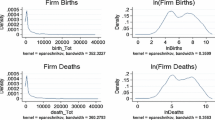Abstract
Traditional models of entry-deterrence typically emphasize sunk costs or predatory pricing, but unionization might also discourage potential entrants. This paper explores this possibility through an empirical model of entry that includes unionization as an explanatory variable. We find that unionization has a statistically significant entry-deterring effect.
Similar content being viewed by others
References
Acs, Z.J., and D.B. Audretsch.Innovation and Small Firms. Cambridge: MIT Press, 1990.
Baumol, W.J., and R.D. Willig. “Fixed Cost, Sunk Cost, Entry Barriers, and Sustainability of Monopoly.”Quarterly Journal of Economics 95 (August 1981): 405–31.
Carter, J.R. “Collusion, Efficiency, and Antitrust.”Journal of Law and Economics 21 (October 1978): 435–44.
Caves, R.E., and T.A. Pugel.Intraindustry Differences in Conduct and Performance: Variable Strategies in U.S. Manufacturing Industries. New York: New York University Press, 1980.
Chappell, W.F., M.S. Kimenyi, and W.J. Mayer. “A Poisson Probability Model of Entry and Market Structure with an Application to U.S. Industries During 1972–77.”Southern Economic Journal 56 (April 1990): 918–27.
Chappell, W.F., W.J. Mayer, and W.F. Shughart. “Union Rents and Market Structure Revisited.”Journal of Labor Research 12 (Winter 1991): 35–46.
Chappell, W.F., and R.L. Cottle. “Sources of Concentration-Related Profits.”Southern Economic Journal 51 (April 1985): 1031–37.
Clark, K.B. “Unionization and Firm Performance: The Impact on Profits, Growth, and Productivity.”American Economic Review 74 (December 1984): 893–919.
Dewartripont, M. “Entry Deterrence under Trade Unions.”European Economic Review 31 (February/March 1987): 149–56.
_____ “Commitment through Renegotiation-Proof Contracts with Third Parties.”Review of Economic Studies 55 (July 1988): 377–89.
Domowitz, I., R.G. Hubbard, and B.C. Peterson. “The Intertemporal Stability of Concentration-Margins Relationship.”Journal of Industrial Economics 35 (September 1986): 13–34.
Duetsch, L.L. “Structure, Performance, and the Net Rate of Entry into Manufacturing Industry.”Southern Economic Journal 41 (January 1975): 450–56.
_____ “Entry and the Extent of Multiplant Operations.”Journal of Industrial Economics 32 (June 1984): 477–87.
Dunne, T., M.J. Roberts, and L. Samuelson. “Patterns of Firm Entry and Exit in U.S. Manufacturing Industries.”Rand Journal of Economics 19 (Winter 1988): 495–515.
Dunne, T., and D.A. Macpherson. “Unionism and Gross Employment Flows.” Working paper, 1991.
Flanagan, R.J. “Wage Interdependence in Unionized Labor Markets.”Brookings Papers on Economic Activity 3 (1976): 653–73.
Freeman, R.B., and J.L. Medoff. “New Estimates of Private Sector Unionism in the United States.”Industrial and Labor Relations Review 32-2 (January 1979): 143–74.
Gorecki, P.K. “The Determinants of Entry by New and Diversifying Enterprises in the U.K. Manufacturing Sector 1958–1963: Some Tentative Results.”Applied Economics 7 (June 1975): 139–47.
_____ “The Determinants of Entry by Domestic and Foreign Enterprises in Canadian Manufacturing Industries: Some Comments and Empirical Results.”Review of Economics and Statistics 58 (November 1976): 485–88.
Hirsch, B.T. “Market Structure, Union Rent Seeking, and Firm Profitability.”Economics Letters 32 (1990): 75–79.
_____ and R.A. Connolly. “Do Unions Capture Monopoly Profits?”Industrial and Labor Relations Review 41 (October 1987): 118–36.
Hundley, Greg. “The Threat of Unionization and Wage-Coverage Effects.”Journal of Labor Research 8 (Summer 1987): 237–51.
Karier, T. “Unions and Monopoly Profits.”Review of Economics and Statistics 67 (February 1985): 34–42.
Kessides, I. “Advertising, Sunk Costs, and Barriers to Entry.”Review of Economics and Statistics 68 (February 1986): 84–95.
_____ “Towards a Testable Model of Entry: A Study of U.S. Manufacturing Industries.”Economica 57 (May 1990): 219–38.
MacDonald, J.M. “Entry and Exit on the Competitive Fringe.”Southern Economic Journal 52 (January 1986): 640–52.
Maloney, M.T., R.E. McCormick, and R.D. Tollison. “Achieving Cartel Profits through Unionization.”Southern Economic Journal 46 (October 1979): 628–34.
Martin, S., and C. Rence. “Vertical Spillovers, Market Concentration, Union Coverage, and Wages.”Journal of Labor Research 5 (Spring 1984): 177–89.
Masson, R.T., and J. Shaanan. “Stochastic-Dynamic Limit Pricing: An Empirical Test.”Review of Economics and Statistics 64 (August 1982): 413–22.
Mills, D.E. “Demand Fluctuations and Endogenous Firm Flexibility.”Journal of Industrial Economics 33 (September 1984): 55–71.
_____ and L. Schumann. “Industry Structure with Fluctuating Demand.”American Economic Review 75 (September 1985): 758–767.
Moore, W.J., R.J. Newman, and J. Cunningham.“The Effect of the Extent of Unionization on Union and Nonunion Wages.”Journal of Labor Research 6 (Winter 1985): 21–44.
Rosen, S. “Trade Union Power, Threat Effects and the Extent of Unionization.”Review of Economics Studies 36 (April 1969): 185–96.
Salinger, M. “Tobin’s q, Unionization, and the Concentration-Profits Relationship.”Rand Journal of Economics 15 (Summer 1984): 159–70.
Salop, S.C., and D.T. Scheffman. “Raising Rivals’ Costs.”American Economic Review 73 (May 1983): 267–71.
_____. “Cost-raising Strategies.”Journal of Industrial Economics 36 (September 1987): 19–34.
Schmalensee, R. “Inter-Industry Studies of Structure and Performance.” InHandbook of Industrial Organization, Vol. 2. Edited by R. Schmalensee and R.D. Willig. Amsterdam: North-Holland, 1989.
Stigler, G.J.Capital and Rate of Return in Manufacturing Industries. Princeton, N.J.: Princeton University Press, 1963.
Vroman, S. “The Direction of Wage Spillovers in Manufacturing.”Industrial and Labor Relations Review 36 (October 1982): 102–12.
Williamson, O.E. “Wage Rates as a Barrier to Entry: The Pennington Case in Perspective.”Quarterly Journal of Economics 82 (February 1968): 85–116.
Author information
Authors and Affiliations
Rights and permissions
About this article
Cite this article
Chappell, W.F., Kimenyi, M.S. & Mayer, W.J. The impact of unionization on the entry of firms: Evidence from U.S. industries. Journal of Labor Research 13, 273–283 (1992). https://doi.org/10.1007/BF02685485
Issue Date:
DOI: https://doi.org/10.1007/BF02685485




